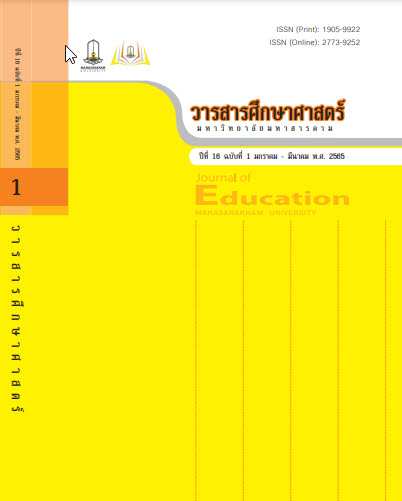The Development of Listening and Speaking Abilities using the B-SLIM Model with Multimedia for Mattayomsuksa 4 Students
Main Article Content
Abstract
The purposes of this study were: 1) to develop instructional Chinese plans using the B-SLIM model with multimedia for Mathayomsuksa four students based on the 70/70 efficient standard, 2) to compare the before and after listening scores of students using the B-SLIM model with multimedia, and 3) to compare the before and after speaking scores of students using the B-SLIM model with Multimedia. The sample group consisted of six students, selected by purposive sampling. The research instruments were 1) The lesson plans based on B-SLIM model with multimedia 5 plans, 2) The test for listening ability 20 items and for speaking ability 1 item. The statistical analysis employed were mean, percentage, standard deviation, and E1/E2. The results of the research were as
follows: 1) Instructional Chinese plans using B-SLIM model with multimedia for Mathayomsuksa 4 students was 78.33/77.60, which was higher than the requirement 70/70 efficiency criterion, 2) The listening mean score before using B-SLIM model with multimedia
was 8.33 or 41.67 percent, with a standard deviation of 0.52, and after was 16.17 or 80.83 percent, with standard deviation of 0.98. The post-test mean score was higher than that of the pre-test, and 3) The speaking mean score before using B-SLIM model with multimedia was 3.83 or 31.94 percent, with a standard deviation of 0.98, and after was 8.67 or 72.22 percent, with standard deviation of 0.52. The post-test mean score was higher than that of the pre-test.
Downloads
Article Details

This work is licensed under a Creative Commons Attribution-NonCommercial-NoDerivatives 4.0 International License.
References
กระทรวงศึกษาธิการ. (2560). ตัวชี้วัดและสาระการเรียนรู้แกนกลาง กลุ่มสาระการเรียนรู้ภาษาต่างประเทศ ตามหลักสูตรแกนกลางการศึกษาขั้นพื้นฐาน พุทธศักราช 2551. กรุงเทพฯ: โรงพิมพ์ชุมนุมสหกรณ์การเกษตร แห่งประเทศไทย จำกัด.
กิดานันท์ มลิทอง. (2548). เทคโนโลยีและการสื่อสารเพื่อการศึกษา. กรุงเทพฯ: ห้างหุ้นส่วนจำกัด อรุณการพิมพ์.
ธัญญารัตน์ มะลาศรี และ Wei Jingru. (2560). การจัดการเรียนการสอนเพื่อพัฒนาทักษะการฟังและการพูดภาษาจีนสำ หรับผู้เรียนชาวไทย. วารสารวิจัยราชภัฏกรุงเก่า, 4 (3), 81-90.
ธูปทอง กว้างสวาสดิ์. (2544). คู่มือการสอนภาษาอังกฤษ. มหาสารคาม: สำนักพิมพ์มหาวิทยาลัยมหาสารคาม.
ธูปทอง กว้างสวาสดิ์. (2549). คู่มือการสอนภาษาอังกฤษ. กรุงเทพฯ: โรงพิมพ์เดือนตุลา.
ปารณัท ศุภพิมล และจารุณี มณีกุล. (2561). การใช้การสอนแบบบีสลิมเพื่อส่งเสริมทักษะทางภาษาอังกฤษ ของนักเรียนชั้นมัธยมศึกษาปีที่ 2. วารสารศึกษาศาสตร์ มหาวิทยาลัยนเรศวร, 20(3), 130-140.
ปิ่นมณี พันหนองแสน และ Xinyu, Z. (2562, 24 พฤษภาคม). ครูผู้สอนรายวิชาภาษาจีน/Interviewer: ธนาภา สิงหลสาย. โรงเรียนสุวรรณภูมิพิทยไพศาล.
ไพริน มูหลาน สกุลเล็ก. (2556). ความรู้พื้นฐานเรื่องการสื่อสาร. Retrieved from https://www.gotoknow.org/posts/521170.
วิภาวี ไชยทองศรี. (2563). การพัฒนาความสามารถด้านการฟัง-พูดภาษาอังกฤษเพื่อการสื่อสารโดยการใช้สถานการณ์จำ ลองของนักเรียนชั้นมัธยมศึกษาปีที่ 3. วารสารวิชาการมหาวิทยาลัยราชภัฏอุดรธานี, 8 (1), 120-136.
ศิริดา ทาทิพย์ และปริณ ทนันชัยบุตร. (2559). การพัฒนาความสามารถด้านการฟังและการพูดภาษาเกาหลี ของนักเรียนชั้นมัธยมศึกษาปีที่ 3 โดยการจัดการเรียนรู้แบบ B-SLIM ร่วมกับกิจกรรมบทบาทสมมติ. วารสารศึกษาศาสตร์ ฉบับวิจัยบัณฑิตศึกษา มหาวิทยาลัยขอนแก่น, ฉบับพิเศษ, 135-140.
สุภาภรณ์ ถิรศิลาเวทย์. (2562). การพัฒนาความสามารถด้านการฟังและการพูดภาษาจีนเพื่อการสื่อสาร ของนักเรียนชั้นมัธยมศึกษาปีที่ 4 ด้วยกิจกรรมตามรูปแบบ B-SLIM ประกอบสื่อมัลติมีเดีย. มหาวิทยาลัยราชภัฎมหาสารคาม, มหาสารคาม.


